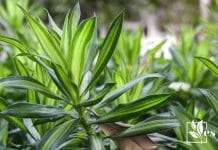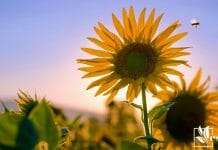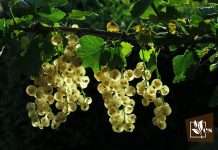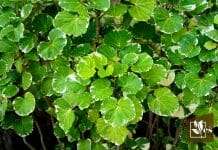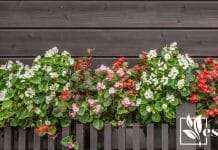Looking for tall shrubs for shade? This article gives you details on the growth habits, appearance, and care of 17 tall shrubs for shade gardens. These plants grow well in outside areas and some provide exceptional shade and privacy to yards and buildings.
People have been growing shade-loving shrubs around their homes and communities for centuries, and in the process, advice comes down to us from experienced gardeners about the best tall shrubs for shade and how to grow them.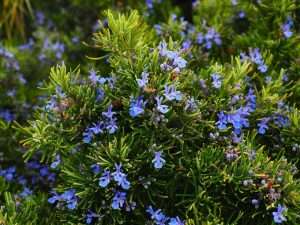
JUMP TO TOPIC
Tall Shrubs for Shade: Why Having Them?
Tall shrubs that do well in shade can be harder to find than sun-loving shrubs. Finding the right shade-tolerant shrubs for your particular climate and location can feel overwhelming.
But many gardeners have sorted out the possibilities, coming up with recommendations for shade-tolerant shrubs and trees, and we can benefit from their collective experience.
Here are 17 of the highest gardener-recommended tall shade plants and shrubs that grow well in shady conditions.
17 Best Tall Shrubs for Shade – This list is divided into three categories:
- Flowering Shrubs for Shade,
- Evergreen Shade Tolerant Shrubs, and
- Large Shrubs for Shade and Privacy.
Many species of plants that grow best in the sun have particular varieties that prefer shade. Which shade-loving shrub is best for you depends on your climate, soil type, planting site, and personal preference.
Many flowering shrubs are deciduous, meaning they lose their leaves in winter. However, many deciduous shrubs thrive in low-light environments and survive, albeit dormant, even when they don’t have leaves during cold months. Evergreens retain their leaves all year-round, and many evergreen shade-loving shrubs flower abundantly.
Before selecting a shrub to plant, be sure to check your USDA growing zone number. Then match your grow zone number to a shrub variety that thrives in your zone. Once you know your grow zone, it’s easier to narrow down which plants are suitable where you live.
A pH soil test to determine the acidity or alkalinity of your soil helps you further narrow down the best choice for your planting site when choosing new shade-tolerant shrubs.
Flowering List
The flowering shrubs in this list are deciduous or have deciduous varieties.
1. Azaleas Species
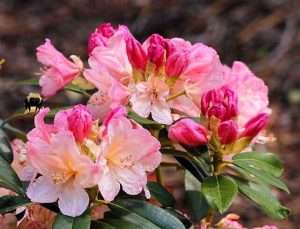
Enjoy the funnel-shaped, single flowers of this species, boasting vibrant and long-lasting blooms that make a striking addition to any garden. Their visual appeal adds a delightful touch to your outdoor space.
Thrive in climate zones 4-9 due to their adaptability to a range of temperatures, soil types, and moisture levels. They are hardy enough to withstand colder winters in zone 4, while still flourishing in milder climates up to zone 9.
Can vary in size, with some reaching heights of up to 20 feet. This substantial height can pose challenges for gardeners in terms of maintenance, pruning, and ensuring they don't overshadow other nearby plants.
To ensure optimal health, these plants thrive in slightly acidic soil. When the soil pH shifts towards alkaline, their leaves may start to yellow, signaling a need for immediate attention.
2. Oakleaf Hydrangea (Hydrangea Quercifolia)
Large white flower clusters appear from stems in summer. Large, oak-shaped leaves with a fuzzy surface. Leaves turn orange and red in autumn. Attractive bark with a furry texture.
Thrive in Climate Zones 5-9, but providing frost protection is crucial, particularly for young plants. These zones experience colder temperatures, posing a risk to tender foliage and growth. Using mulch, burlap wraps, and occasional winter coverings can safeguard against frost damage.
Up to 12 feet tall, this shrub boasts impressive height, adding vertical interest to your garden. Consider its sprawling growth when planning your landscape, ensuring ample space and strategic placement for optimal aesthetics. Prune judiciously to maintain desired size.
Plant in rich, well-draining soil with consistent moisture. Prune spent flowers in late winter to encourage new growth. It thrives in partial shade, creating a lush, textural element in your garden.
3. Viburnum Acerfolium
A low-maintenance, easy to grow shrub with pleasant flower clusters appearing in spring and dark berries later in summer. Leaves turn an attractive yellow in fall. Colonies can grow from suckers.
Clusters of small white flowers in spring give way to striking red to black berries in fall, while the foliage turns vibrant hues, making it a visually appealing addition to any garden
Suitable for USDA hardiness zones 3-8, this species exhibits adaptability to a wide range of climates, allowing for diverse landscaping possibilities. Gardeners should consider local conditions for optimal growth.
This particular species typically reaches a height of up to 8 feet, with a maximum width of 4 feet. This size has implications for spacing, pruning, and creating a balanced garden composition. landscape, ensuring ample space and strategic placement for optimal aesthetics. Prune judiciously to maintain desired size.
This species thrives in well-drained, slightly acidic soil. Allowing the natural suckering behavior to form a dense colony can enhance visual appeal and habitat value in your garden.
4. Serviceberry (Amerlanchier Species)
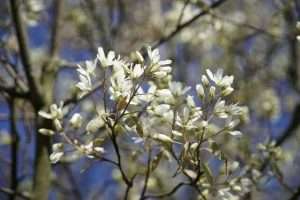
The Serviceberry (Amelanchier species) is an upright tree with white flowers, dark berries, and an attractive silver-shaded trunk. Its elegant appearance adds ornamental value to any garden while providing wildlife-friendly berries. Prune for a balanced shape and enjoy its seasonal beauty.
To successfully cultivate this plant, consider its adaptability across climate zones 2-9. Tailor care to suit your specific zone, emphasizing cold hardiness in lower zones and heat tolerance in higher ones. Prune and shape as needed to encourage healthy growth in your climate.
When considering the size of this particular species, it's crucial to note its potential height of 15 to 20 feet. This impacts landscape planning, requiring adequate spacing and regular pruning to maintain shape and size. Properly managed, it can create an attractive, balanced focal point in your garden.
Ensure the planting site offers moist, well-drained soil for optimal growth. Regular pruning encourages better fruit production and shape. Protect from birds during fruiting season to maximize harvest.
5. Summersweet Clethra (Clethra Alnifolia)
This shrub graces gardens with scented, white blossoms in summer, transitioning to a stunning display of attractive yellow leaves in fall, all supported by its robust and thick branch structure. A versatile, multi-seasonal beauty.
Selecting the right location is key when cultivating Summersweet Clethra, as it thrives in USDA hardiness zones 4-9. Understanding your local climate and soil conditions is crucial for successful growth and abundant blooms.
Optimal growth for this plant ranges from 4 to 8 feet in height and 4 to 6 feet in width. To ensure healthy development, consider factors such as soil quality, sunlight, and pruning techniques accordingly.
To ensure the thriving health of Summersweet Clethra (Clethra Alnifolia), plant it in well-drained, moist soil. It gracefully tolerates salt spray and stays low-maintenance, but offering some sun.
6. Japanese Kerria (Kerria Japonica)
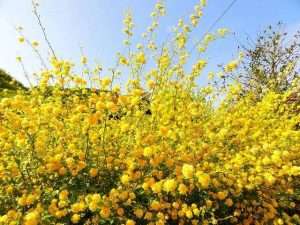
Enhance your garden's visual allure with vibrant, rose-like bright-yellow blossoms, gracefully adorning a sturdy, densely branched, upright green-stemmed structure. Achieve an eye-catching focal point while ensuring resilience and ease of maintenance.
For thriving in zones 4-9, prioritize well-drained soil, partial shade to full sun, and occasional pruning to rejuvenate growth. Adjust watering to balance drought resistance and consistent moisture for optimal health.
For optimal growth, prune this shrub to maintain a height of up to 6 feet, promoting healthier branching, better flowering, and easier garden management while preserving its natural beauty.
Thrives in diverse soils, handling poor quality with grace. Optimal performance in hot climates with periodic watering; adapts to drought conditions. Exercise caution with watering frequency, and trim post-bloom for best results.
7. Slender Deutzia (Deutzia Gracilis)
This shrub produces brilliant, long-lasting blossoms in mid-spring. While not very tall, it is still among the best of shade-loving shrubs for planting in low-light areas.
This plant features delicate white or pink blooms on multiple upright stems. Its arching branches create an elegant silhouette, complemented by attractive dark-green leaves. However, it doesn't offer vibrant fall foliage.
This beauty thrives in climate zones 5-8, where its adaptability to both cold and moderate temperatures makes it a versatile and resilient addition to gardens in these regions
To maintain a balanced and healthy growth, ensure adequate spacing, as this plant typically reaches 5 to 6 feet tall and wide. Prune selectively to encourage air circulation and sunlight penetration, preventing disease and promoting vigorous foliage development.
To ensure optimal growth and appearance, maintain consistent moisture during hot spells, while annually removing lifeless stems to stimulate healthy new growth.
8. Flowering Dogwood (Cornus Florida)
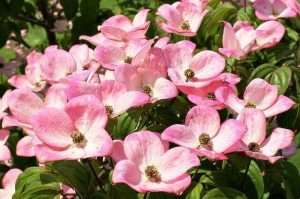
The blossoms on Flowering Dogwood are actually a tight clump of small, inconspicuous flowers with an outer ring of bracts, which look like four big flower petals. These small trees grow quickly, attaining a full height in as little as ten years.
The plant boasts a distinctive single or multi-stemmed trunk and a broad, pyramid-shaped branch structure with a rounded canopy. Its stunning springtime floral exhibitions are complemented by striking reddish-hued foliage during the autumn months.
To successfully cultivate this species, consider the wide range of climate zones (3-8) it can thrive in. Tailor care to suit local conditions, focusing on cold hardiness, heat tolerance, and soil adaptability.
Consider the mature height of 15 to 30 feet when planning for this species. This variability requires careful spacing and pruning to maintain the desired scale and aesthetics in your garden design.
To ensure optimal growth, provide the plant with moist, well-drained soil enriched with compost or decomposed organic matter. Avoid frequent pruning; only trim as needed. Maintain consistent but not waterlogged soil during dry periods.
Evergreen List
Evergreen shrubs don’t lose their leaves in winter, helping them provide more shade and privacy all year round compared to deciduous shrubs. These evergreen shrubs also grow well in low-light conditions when planted outdoors.
9. Camellia Species
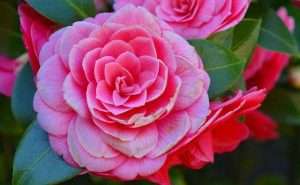
Showy white, pink, or red blossoms, some types with fragrance, make this species a prized addition to any garden. Its glossy evergreen foliage adds year-round appeal, but proper pruning is essential to maintain its elegant form and ensure bountiful blooms.
To successfully cultivate in Climate Zones 6-10, prioritize well-drained acidic soil, ample moisture, and winter protection to safeguard against frost damage. Pruning after flowering encourages healthy growth.
This particular species typically reaches a height of 10 to 20 feet tall with a spread of 5 to 7 feet wide, requiring adequate space and regular pruning to maintain its desired size and shape.
To ensure optimal growth for this plant, select a planting location with well-drained, slightly acidic soil. This will promote healthy root development, nutrient uptake, and overall vitality.
10. Japanese Andromeda (Pieris Japonica)
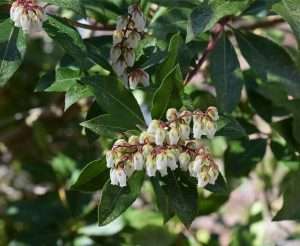
Mildly fragrant flowers appear in the early spring and are popular with bees and other pollinator insects. This shrub is also called lily-of-the-valley and Japanese pieris.
Foster a captivating appearance with elegant white or pink, bell-shaped, hanging flower clusters. Encourage a bushy growth habit through regular pruning, allowing the deep green leaves to provide a striking backdrop for these exquisite floral displays in your garden.
To successfully cultivate this plant, select a well-draining soil. In zones 5-9, ensure proper winter protection and maintain consistent moisture levels during the growing season. Prune after flowering to encourage healthy growth.
To address the size of this plant, expect it to reach a height of 9 to 12 feet tall and spread out to 6 to 8 feet wide. This growth pattern necessitates strategic placement and regular pruning to maintain a compact and aesthetically pleasing shape.
To ensure optimal growth, provide well-drained, moist, and fertile soil with a slightly acidic pH. This plant benefits from camellia fertilizer, but avoid alkaline soils, as they can hinder its development.
11. Rhododendron Species
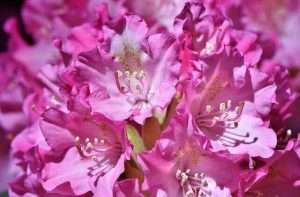
The sizes of these plants vary considerably, depending on the variety. Larger types grow to tree-sized heights. Some varieties grow slowly and others much more rapidly.
Showy flowers and dark-green leaves on multiple, upright woody stems create a captivating focal point in any garden. Benefiting from regular pruning for optimal shape and vigor.
Suited to Zones 5-11, depending on the variety. Tailor care to regional climates, ensuring adequate winter protection in colder zones and careful sun exposure management in warmer ones.
Its potential size can reach up to 20 feet. This necessitates thoughtful planning to ensure proper spacing and room for growth in your garden. Prune to promote optimal health and aesthetics while preventing overcrowding.
Shield these beauties from strong winds to protect their delicate foliage. After they've settled in, their low-maintenance nature shines. Opt for acidic, loamy soil and exercise restraint in watering.
12. Mountain Laurel (Kalmia Latifolia)
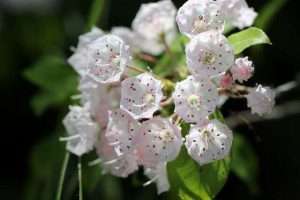
The attractive, thick leaves stay on the plant all year, giving it a pleasing appearance when the flowers have faded.
Achieving an exquisite aesthetic with smooth, glossy, dark foliage and cultivating vibrant large flower clusters in various shades of white, pink, purple, and multicolor blooms poses a delightful challenge for gardeners.
For optimal growth and bloom success, focus on providing well-drained soil, ample mulch, and occasional pruning. In Zones 4-9, monitor moisture levels and choose appropriate varieties to suit your local climate.
This plant can grow between 8 to 10 feet tall and spread 5 to 15 feet wide. Be mindful of spacing to accommodate its potential size and consider pruning for shape and space management.
To foster thriving growth, cultivate a soil environment rich in acidity, moisture, and fertility, allowing for efficient drainage. Maximizing filtered sunlight exposure will yield an abundance of beautiful blossoms in your garden.
13. Glossy Abelia (Abelia x Grandiflora)
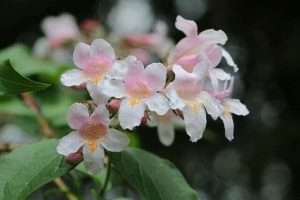
Abelia is actually a semi-evergreen with leaves that turn a stunning bronze shade in late fall and winter without the shrub ever going completely bare of leaves. Some varieties are especially cold hardy and flower later in the season.
A striking feature of this shrub lies in its conical branch structure, adorned with small, evergreen needles. In summer, it boasts small, red berries, which transform into charming miniature cones come fall. These characteristics offer a unique blend of structure and color, making it a valuable addition to any garden.
For optimal growth, choose a loamy, medium-moist, well-draining soil. This versatile plant thrives in both sunny and shady spots, adapting well to various light conditions.
Size of this plant varies, reaching up to 20 feet. Varieties exist with different growth patterns, so consider your garden's space and desired aesthetic when planting. Pruning can help control size and maintain shape.
To foster thriving growth, cultivate a soil environment rich in acidity, moisture, and fertility, allowing for efficient drainage. Maximizing filtered sunlight exposure will yield an abundance of beautiful blossoms in your garden.
14. Yew (Taxus Baccata)
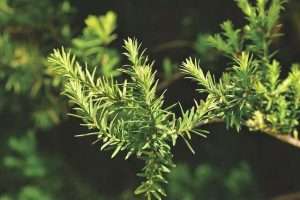
Yew plants are easy to clip and train into all sorts of shapes, making them useful as hedges and decorative plantings in shady areas. People use sprigs of Yew as Christmas decorations in many places around the world.
This specimen features a multi-stemmed, upright growth pattern with a V-shaped branch structure. Its blossoms sport shades of yellow, sometimes with hints of red and orange, while its fruits transition from green to brown. These features hold significance for gardening and landscaping choices.
Consider the specific variety's adaptability within zones 2-10. Careful attention to soil pH, drainage, and sunlight requirements is vital for optimal growth and health, as these factors can significantly impact the plant's longevity and overall appearance.
This plant's size can extend up to 20 feet, with variations among different varieties. It's vital to factor in this growth potential when designing your garden layout to allow ample space and accommodate future growth, ensuring a healthy and aesthetically pleasing landscape.
Achieving ideal growth for this plant hinges on cultivating a loamy, medium-moist, well-draining soil. Remarkably adaptable, it flourishes in both sun-drenched spots and shaded corners, showcasing its resilience and suitability for diverse garden environments.
Large Tall List
The first two on this list are small trees, but they are tall shade plants worth considering for garden areas with low-light levels.
15. Witch Hazel (Hamamelis Species)
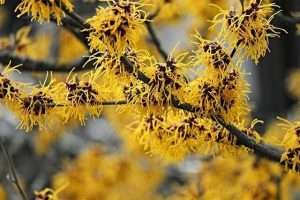
Flowers bloom in late fall and early winter after the leaves drop. Seed capsule fruits mature slowly over the winter and the following season, then burst open, ejecting the seeds up to 10 yards.
This plant features an upright, V-shaped branch structure with yellow flowers tinged in red and orange. It bears small, green-to-brown fruits, offering both structural appeal and vibrant floral ornamentation in gardens.
This is a versatile and hardy shrub, thriving in USDA climate zones 3-8. Its adaptability to a wide range of temperatures makes it an excellent choice for gardeners seeking year-round beauty and fragrance.
For optimal growth, consider that this species can reach a mature size of 15 to 20 feet in both height and width. Prune selectively to maintain desired dimensions and encourage healthy branching patterns.
For optimal growth, Witch Hazels thrive in filtered sunlight but can endure shade. Maintain medium moisture levels and choose nutrient-rich, acidic soil. This ensures their vibrant health and the best performance in your garden.
16. Canadian Hemlock Tree (Tsuga Canadensis)
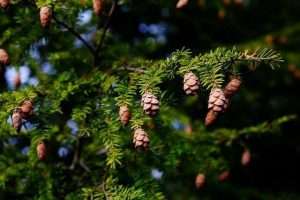
This plant is entirely unrelated to the poisonous hemlock plant. Canadian Hemlock is a full-sized tree that grows well in shady areas, providing beauty and protection to the garden.
The tree exhibits a graceful form with several vertical stems, creating a distinctive V-shaped branch structure. During flowering, it produces yellow blossoms, occasionally displaying shades of red and orange. As the seasons shift, the tree bears small, green to brown fruits.
Thrives in zones 3-7, showcasing its adaptability to a wide range of climates. Gardeners should consider its preference for well-drained soil, partial shade, and protection from harsh winter winds.
A tree reaching 40 to 70 feet, the Canadian Hemlock is an ideal choice for adding vertical dimension to a garden. It demands strategic planting to prevent overshadowing and benefits from occasional pruning to maintain its graceful form.
For optimal growth, provide medium water levels and ensure well-drained soil. Shield from harsh winds and dry conditions, as it's sensitive to drought. Applying mulch around the base retains moisture, or allow fallen needles to accumulate for natural conservation.
17. Bamboo (Bambusoideae Species)
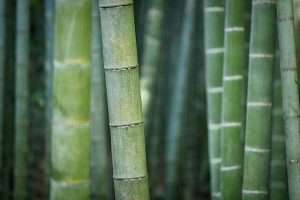
Clumping bamboo varieties tend to stay put where you plant them, growing in non-invasive clumps. Some gardeners also plant bamboo in containers to restrain its growth. The bamboo variety known as umbrella bamboo (Fargesia robusta) is a clumping variety that grows particularly well in shady garden locations.
Careful cultivation results in a striking sight - multiple-stems with an upright, V-shaped branch structure. Their skillful touch brings forth vibrant yellow flowers, occasionally adorned with hints of red and orange, while the fruits mature from green to a rich brown, showcasing their horticultural prowess.
Select hardy varieties for zones 6-9 to ensure successful growth. In colder climates (zone 6), provide winter protection or plant in a sheltered spot. In warmer zones (7-9), monitor soil moisture and provide shade during scorching summers to maintain optimal growth.
When cultivating this species, it's vital to consider its potential height, which can reach up to 18 feet. Be prepared to provide ample space and support structures to accommodate its towering growth, ensuring a thriving and visually appealing garden.
For optimal growth, maintain consistently moist, slightly acidic soil to support this plant's health. Ensure well-drained conditions to prevent root rot and promote vigorous growth.
Planting and Caring
You can buy shrubs in containers, with roots wrapped in burlap, or bare-root. Most shrubs benefit from adding compost and other soil amendments to the planting site before planting. You can ask at a plant nursery about what to add to the soil for the shrub you are growing.
How much water and fertilizer a shrub needs depends entirely on the species and variety. When you buy shrubs in containers for planting in the garden, look for a plastic tag in the container with information about the requirements for that plant, and follow these instructions for the best results.
Many shrubs are low-maintenance and need only a small amount of granular fertilizer once a year in spring during their first few years. After that, many shrubs do fine without further fertilizing provided they are planted in the correct soil to start.
Water requirements also vary considerably between species of shrub. The best way to know how much to water is to research specific watering needs of the variety you are planting and consider this along with how much water your area gets in rain and snow. However, apart from the rain and snow, you can water them using tap water, preferably purified.


